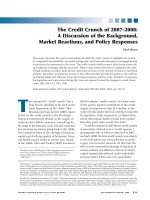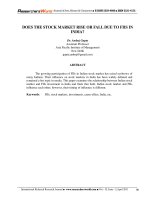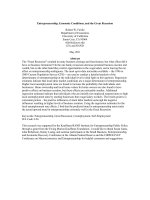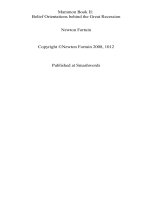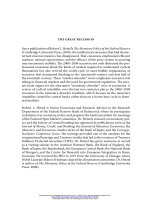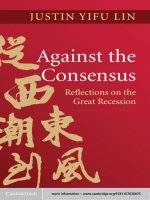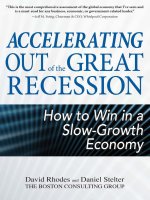hetzel - the great recession; market failure or policy failure (2012)
Bạn đang xem bản rút gọn của tài liệu. Xem và tải ngay bản đầy đủ của tài liệu tại đây (4.73 MB, 420 trang )
THE GREAT RECESSION
Since publication of Robert L. Hetzel’s e Monetary Policy of the Federal Reserve
(Cambridge University Press, 2008 ), the intellectual consensus that had charac-
terized macroeconomics has disappeared. at consensus emphasized e cient
markets, rational expectations, and the e cacy of the price system in assuring
macroeconomic stability. e 2008–2009 recession not only destroyed the pro-
fessional consensus about the kinds of models required to understand cyclical
uctuations but also revived the credit-cycle or asset-bubble explanations of
recession that dominated thinking in the nineteenth century and rst half of
the twentieth century. ese “market-disorder” views emphasize excessive risk
taking in nancial markets and the need for government regulation. e pres-
ent book argues for the alternative “monetary-disorder” view of recessions. A
review of cyclical instability over the last two centuries places the 2008–2009
recession in the monetary-disorder tradition, which focuses on the monetary
instability created by central banks rather than on a boom-bust cycle in nan-
cial markets.
Robert L. Hetzel is Senior Economist and Research Advisor in the Research
Department of the Federal Reserve Bank of Richmond, where he participates
in debates over monetary policy and prepares the bank’s president for meetings
of the Federal Open Market Committee. Dr. Hetzel’s research on monetary pol-
icy and the history of central banking has appeared in publications such as the
Journal of Money, Credit, and Banking; the Journal of Monetary Economics ; the
Monetary and Economics Studies series of the Bank of Japan; and the Carnegie-
Rochester Conference Series . His writings provided one of the catalysts for the
congressional hearings and Treasury studies that led to the issuance of Treasury
In ation Protected Securities (TIPS). Dr. Hetzel has given seminars or served
as a visiting scholar at the Austrian National Bank, the Bank of England, the
Bank of Japan, the Bundesbank, the European Central Bank, the National Bank
of Hungary, and the Center for Research into European Integration in Bonn,
Germany. He received his PhD in 1975 from the University of Chicago, where
Nobel Laureate Milton Friedman chaired his dissertation committee. Dr. Hetzel
is author of e Monetary Policy of the Federal Reserve (Cambridge University
Press, 2008 ).
Downloaded from Cambridge Books Online by IP 14.139.43.12 on Sat Oct 06 08:32:42 BST 2012.
/>Cambridge Books Online © Cambridge University Press, 2012
Downloaded from Cambridge Books Online by IP 14.139.43.12 on Sat Oct 06 08:32:42 BST 2012.
/>Cambridge Books Online © Cambridge University Press, 2012
Studies in Macroeconomic History
Series Editor:
M i c h a e l D . B o r d o , Rutgers University
Editors:
M a r c F l a n d r e a u , Institut d’Etudes Politiques de Paris
Chris Meissner , University of California, Davis
F r a n ç o i s V e l d e , Federal Reserve Bank of Chicago
David C. Wheelock , Federal Reserve Bank of St. Louis
e titles in this series investigate themes of interest to economists and economic
historians in the rapidly developing eld of macroeconomic history. e four areas
covered include the application of monetary and nance theory, international economics,
and quantitative methods to historical problems; the historical application of growth
and development theory and theories of business uctuations; the history of domestic
and international monetary, nancial, and other macroeconomic institutions; and the
history of international monetary and nancial systems. e series amalgamates the
former Cambridge University Press series Studies in Monetary and Financial History and
Studies in Quantitative Economic History .
Other books in the series:
H o w a r d B o d e n h o r n , A History of Banking in Antebellum America [9780521662857,
9780521669993]
M i c h a e l D . B o r d o , e Gold Standard and Related Regimes [9780521550062,
9780521022941]
Michael D. Bordo and Forrest Capie (eds.), Monetary Regimes in Transition
[9780521419062]
Michael D. Bordo and Roberto Cortés-Conde (eds.), Transferring Wealth and Power
from the Old to the New World [9780521773058, 9780511664793]
Michael D. Bordo and Ronald MacDonald , Credibility and the International Monetary
Regime: A Historical Perspective [9780521811330]
Claudio Borio , Gianni Toniolo , and Piet Clement (eds.), Past and Future of Central Bank
Cooperation [9780521877794, 9780511510779]
Richard Burdekin and Pierre Siklos (eds.), De ation: Current and Historical Perspectives
[9780521837996, 9780511607004]
Forrest Capie , e Bank of England: 1950s to 1979 [9780521192828]
Trevor J. O. Dick and John E. Floyd , Canada and the Gold Standard [9780521404082,
9780521617062]
Barry Eichengreen , Elusive Stability [9780521365383, 9780521448475, 9780511664397]
Barry Eichengreen (ed.), Europe’s Postwar Recovery [9780521482790, 9780521030786]
Caroline Fohlin , Finance Capitalism and Germany’s Rise to Industrial Power
[9780521810203, 9780511510908]
(Continued a er index)
Downloaded from Cambridge Books Online by IP 14.139.43.12 on Sat Oct 06 08:32:42 BST 2012.
/>Cambridge Books Online © Cambridge University Press, 2012
Downloaded from Cambridge Books Online by IP 14.139.43.12 on Sat Oct 06 08:32:42 BST 2012.
/>Cambridge Books Online © Cambridge University Press, 2012
h e Great Recession
Market Failure or Policy Failure?
ROBERT L. HETZEL
Senior Economist and Research Advisor
Federal Reserve Bank of Richmond
Downloaded from Cambridge Books Online by IP 14.139.43.12 on Sat Oct 06 08:32:42 BST 2012.
/>Cambridge Books Online © Cambridge University Press, 2012
Cambridge, New York, Melbourne, Madrid, Cape Town,
Singapore, São Paulo, Delhi, Mexico City
Cambridge University Press
32 Avenue of the Americas, New York , NY 10013-2473, USA
www.cambridge.org
Information on this title: www.cambridge.org /9781107011885
© Robert L. Hetzel 2012
is publication is in copyright. Subject to statutory exception
and to the provisions of relevant collective licensing agreements,
no reproduction of any part may take place without the written
permission of Cambridge University Press.
First published 2012
Printed in the United States of America
A catalog record for this publication is available from the British Library.
Library of Congress Cataloging in Publication data
Hetzel, Robert L.
e great recession : market failure or policy failure? / Robert L. Hetzel.
p. cm.
Includes bibliographical references and index.
ISBN 978-1-107-01188-5 (hbk.)
1. Recessions – United States. 2. Monetary policy – United States.
3. Business cycles – United States. 4. United States – Economic policy – 2009–
5. United States – Economic conditions – 2009– I. Title.
HB3743.H48 2011
330.973–dc23 2011038742
ISBN 978-1-107-01188-5 Hardback
Cambridge University Press has no responsibility for the persistence or accuracy of URLs
for external or third-party Internet Web sites referred to in this publication and does not
guarantee that any content on such Web sites is, or will remain, accurate or appropriate.
Downloaded from Cambridge Books Online by IP 14.139.43.12 on Sat Oct 06 08:32:42 BST 2012.
/>Cambridge Books Online © Cambridge University Press, 2012
vii
List of Figures page ix
L i s t o f T a b l e s xii
P r e f a c e xiii
1 . e 2008–2009 Recession: Market or Policy Maker Failure? 1
2. Recessions: Financial Instability or Monetary Mismanagement? 11
3 . e Great Contraction: 1929–1933 23
4. Monetary Policy and Bank Runs in the Great Depression 46
5. Vigorous Recovery and Relapse: 1933–1939 65
6. Interwar International Monetary Experiments 85
7. Identifying the Shocks that Cause Recessions 110
8. From Stop-Go to the Great Moderation 128
9. Controlling Bank Risk Taking: Market or Regulator Discipline? 149
10. e Housing Crash: Subsidizing Housing and Bank Risk Taking 170
11. Bubble Trouble: Easy Money in 2003 and 2004? 187
12. What Caused the Great Recession of 2008–2009? 204
13. What Caused the Great Leverage Collapse? 239
14. e Distinctions Between Credit, Monetary,
and Liquidity Policy 257
15. Fed Market Interventions: e Experiment with Credit Policy 282
Contents
Downloaded from Cambridge Books Online by IP 14.139.43.12 on Sat Oct 06 08:32:48 BST 2012.
/>Cambridge Books Online © Cambridge University Press, 2012
viii
Contents
16. Evaluating Policy: What Are the Relevant Counterfactuals? 300
17. e Business Cycle: Market Instability or Monetary Instability? 319
18. Why Is Learning So Hard? 330
19. How Should Society Regulate Capitalism? Rules versus
Discretion 342
Postscript 346
B i b l i o g r a p h y 351
I n d e x 377
Downloaded from Cambridge Books Online by IP 14.139.43.12 on Sat Oct 06 08:32:48 BST 2012.
/>Cambridge Books Online © Cambridge University Press, 2012
ix
3.1. Price levels in gold-standard and non-gold-standard
countries: 1873–1893 page 35
4.1. e market for bank reserves 48
4.2. Increase in nonborrowed reserves and decrease
in discount rate 49
4.3. Money-market interest rates and regional Fed
bank discount rates 50
4.4. M2 growth 51
4.5. Federal Reserve credit and currency held by
public: 1928–1940 53
4.6. M2 and total, required and excess reserves of member banks 54
4.7. Change in M2 and deposits of suspended banks 55
5.1. U.S. long-term interest rates 83
7.1. Real output per capita 111
7.2. M2 per unit of output and the price level 117
7.3. M1 step function and recessions: 1906–1945 118
7.4. Money-market rates: 1907–1945 119
8.1. M1 step function and recessions: 1946–1981 134
8.2. Nominal output growth, the funds rate, and M1
step function 135
8.3. Real personal consumption expenditures and trend 138
8.4. Deviation of real PCE from trend, short-term real interest rate,
and in ation: 1966–1982 139
8.5. Deviation of real PCE from trend, short-term real interest rate,
and in ation: 1982–2005 140
8.6. Actual and predicted nominal GDP growth: 1950–1990 141
10.1. Homeownership rate 171
10.2. Real house price growth 172
Figures
Downloaded from Cambridge Books Online by IP 14.139.43.12 on Sat Oct 06 08:32:54 BST 2012.
/>Cambridge Books Online © Cambridge University Press, 2012
x
Figures
10.3. Mortgage debt as a percent of total commercial bank credit 180
10.4. Total residential loans for large commercial banks 180
11.1. Real money-market rates 190
11.2. Short-term real commercial paper rates and
unemployment rates 192
11.3. Growth in real total private debt 194
11.4. Growth in real consumption and in real household debt 195
11.5. Private debt as a percent of GDP 196
11.6. PCE in ation 198
12.1. Real PCE and trend 206
12.2. Deviations of real PCE from trend 206
12.3. Business inventory/sales ratio 207
12.4. Change in inventory/sales ratio and ISM
manufacturing index 207
12.5. Real price of oil 209
12.6. Real personal disposable income and expenditures 209
12.7. Cycle relatives for real disposable personal income 210
12.8. Residential investment’s contribution to GDP growth 210
12.9. Household net worth and home equity wealth
as a percent of income 211
12.10. Total nonfarm payroll employment relative to cycle peak 212
12.11. Change in private nonfarm payrolls 212
12.12. Fed funds rate and real PCE shortfall from trend 214
12.13. International growth 215
12.14. Central bank policy rates 215
12.15. Households expectations about future income growth 222
12.16. New issuance of asset-backed securities 225
12.17. Long-term interest rates 226
12.18. Credit default swap spreads 227
12.19. Nonperforming loans as a percent of total loans 228
12.20. Consumer loan interest rates 229
12.21. Consumer credit 229
12.22. Di culty in obtaining credit for small businesses 230
12.23. Relative importance of nancing di culties for
small businesses 230
12.24. Single most important problem for small
businesses: regulations and taxes 231
12.25. Single most important problem for small
businesses: labor quality and sales 232
12.26. M2 growth 237
Downloaded from Cambridge Books Online by IP 14.139.43.12 on Sat Oct 06 08:32:54 BST 2012.
/>Cambridge Books Online © Cambridge University Press, 2012
xi
Figures
14.1. Federal Reserve System assets 263
14.2. Changing composition of Federal Reserve System assets 264
14.3. Federal Reserve System liabilities 266
14.4. Detailed breakdown of Federal Reserve System assets 267
14.5. e market for reserves without IOR 276
14.6. e market for reserves with IOR as a oor in a tunnel 277
14.7. e market for reserves with IOR as the policy instrument 278
16.1. GDP growth 305
Downloaded from Cambridge Books Online by IP 14.139.43.12 on Sat Oct 06 08:32:54 BST 2012.
/>Cambridge Books Online © Cambridge University Press, 2012
xii
Tables
4.1. Nominal and real rate page 52
5.1. Federal government budget de cit 73
7.1. Behavior of selected series at NBER turning points 121
8.1. M1 steps, nominal output growth, and funds rate 136
8.2. Regression equation predicting M2 velocity 148
10.1. Fannie Mae conforming single-family loan characteristics,
retained + guaranteed September 30, 2009 175
12.1. Contributions to percent changes in real GDP 213
14.1. Programs to stimulate nancial intermediation as of
November 26, 2008 258
Downloaded from Cambridge Books Online by IP 14.139.43.12 on Sat Oct 06 08:33:01 BST 2012.
/>Cambridge Books Online © Cambridge University Press, 2012
Cambridge Books Online
/>The Great Recession
Market Failure or Policy Failure?
Robert L. Hetzel
Book DOI: />Online ISBN: 9780511997563
Hardback ISBN: 9781107011885
Chapter
Preface pp. xiii-xiv
Chapter DOI: />Cambridge University Press
xiii
Preface
Prior to the 2008–2009 recession, considerable professional consensus
existed that a prolonged, deep recession required contractionary monetary
policy. With the 2008–2009 recession, this consensus disappeared. Popular
and professional discourse revived the view that dominated thinking in the
nineteenth century and rst half of the twentieth century. According to
this view, the business cycle derives from excessive swings in risk taking by
investors. Although popular expressions of this view ignore the operation
of the price system, the implicit assumption is that these uctuations in
investor sentiment between optimism and pessimism overwhelm the abil-
ity of the price system and, especially, the real interest rate to maintain full
employment.
In contrast to this market-disorder view, the monetary-disorder view
is that the price system works well to equilibrate the economy, provided
that money creation and destruction do not prevent the interest rate from
adjusting. ere is no inevitable movement from boom to bust. is view
receives empirical content from the hypothesis that to prevent the monet-
ary emissions and absorptions that destabilize the price level, the central
bank must follow a rule that provides for a stable nominal anchor and that
allows market forces to determine the real interest and, by extension, other
real variables (Hetzel 2008b ).
Historically, the term used here, “market-disorder,” has represented
several traditions. Prior to World War II, the term “credit-cycle” or “real
bills ” focused attention on speculative behavior in asset markets that led
to asset “bubbles ,” whose bursting required debt liquidation and de ation.
e Keynesian tradition emphasized swings in the animal spirits of inves-
tors that produced destabilizing uctuations in investment. e contrast-
ing monetary-disorder view summarizes variants of the quantity-theory
tradition.
Downloaded from Cambridge Books Online by IP 14.139.43.12 on Sat Oct 06 08:33:26 BST 2012.
/>Cambridge Books Online © Cambridge University Press, 2012
Preface
xiv
Over time, the intellectual climate has oscillated between the market-
disorder and monetary-disorder views. e former in its credit-cycle mani-
festation dominated thinking in the Depression and returned with vigor
in the 2008–2009 recession. According to this view, excessive risk taking
of banks caused the Depression and the 2008–2009 recession. e change
over time in the intellectual consensus about the cause of the Depression
from a credit-cycle to a monetary-disorder view should make contempor-
ary observers cautious about assigning causes to the 2008–2009 recession
without the advantage of thorough debate and the perspective of time. In
the spirit of such debate, this book runs a horse race between the market-
disorder and monetary-disorder views of the most likely causes of reces-
sions, including the 2008–2009 recession.
e explanation o ered here for both the Depression and the 2008–2009
recession is in the monetary-disorder spirit. To a signi cant extent, the
2008–2009 recession arose because the Federal Reserve departed from a
rule that allowed the price system to work.
e author is indebted to Michael Bordo for a combination of critical
review and encouragement without implicating him in the arguments
expressed in the book. e views in this book are those of the author, not
the Federal Reserve Bank of Richmond or the Federal Reserve System.
Downloaded from Cambridge Books Online by IP 14.139.43.12 on Sat Oct 06 08:33:26 BST 2012.
/>Cambridge Books Online © Cambridge University Press, 2012
Cambridge Books Online
/>The Great Recession
Market Failure or Policy Failure?
Robert L. Hetzel
Book DOI: />Online ISBN: 9780511997563
Hardback ISBN: 9781107011885
Chapter
One - The 2008–2009 Recession pp. 1-10
Chapter DOI: />Cambridge University Press
1
O N E
e 2008–2009 Recession
Market or Policy Maker Failure?
A er the end of the Volcker disin ation in 1983 and through the end of
2007, growth in the world economy proceeded steadily, interrupted only by
two minor recessions starting in 1990 and in 2001. Economists talked about
the Great Moderation. e Great Recession, which began in the United
States in December 2007, came as a shock. Once again, economists and the
public began to ask fundamental questions about the nature of free-market
economies. Are they inherently unstable? What kind of government policy
can stabilize economic uctuations?
is chapter reviews what is at stake in understanding the cause of the
2008–2009 recession. Seemingly commonsensical but misguided responses
to the distress su ered during recession not only can be ine ective, but also
can harm long-term growth. Such responses can also direct public policy
away from the institutional arrangements and policies required to prevent
cyclical instability. e following chapters contrast two explanations of the
business cycle. One explanation highlights market disorder resulting from
swings in the psychology of nancial markets from excessive risk taking to
excessive risk aversion. e other explanation highlights monetary disorder
based on central bank (Federal Reserve) interference with the operation of
the price system.
THE LACK OF AN AGREED CONCEPTUAL
FRAMEWORK FOR CENTRAL BANKING
ere is no agreement over the conceptual framework to use in understand-
ing what the central bank controls and how it exercises its control. is lack
of agreement mirrors the lack of consensus within the economics profession
about the reasons for economic instability. Economists di er over the e cacy
of the price system in maintaining aggregate demand equal to potential output.
Downloaded from Cambridge Books Online by IP 14.139.43.12 on Sat Oct 06 08:33:33 BST 2012.
/>Cambridge Books Online © Cambridge University Press, 2012
e 2008–2009 Recession
2
ey also di er over the role played by expectations about the future. In the
terminology employed here, there have been historically two broad schools of
thought: the market-disorder view and the monetary-disorder view .
Adherents of the market-disorder view believe that sharp swings in
expectations about the future from unfounded optimism to unfounded
pessimism overwhelm the ability of o setting changes in the real interest
rate to stabilize economic activity. ose expectational swings arise inde-
pendently of central bank actions and require discretion in the conduct of
monetary policy. e failure of the price system to mitigate uctuations in
output provides an opening for the central bank and government to man-
age aggregate demand. e central bank can control the real expenditure of
the public through controlling the ow of credit and its allocation – that is,
through controlling the le (asset) side of its balance sheet.
Adherents of the monetary-disorder view believe that the real interest
rate works well as a ywheel to stabilize uctuations in aggregate demand
around potential produced by real demand shocks. However, money cre-
ation and destruction can interfere with those self-equilibrating powers.
e conduct of monetary policy by a rule providing a nominal anchor and
allowing market forces to determine the real interest rate and real output
makes expectations into a stabilizing force by causing the public to antici-
pate that shocks that produce divergences between real aggregate demand
and potential output will be short-lived.
HAS MACROECONOMICS FAILED?
e 2008–2009 recession initiated a vigorous debate over the relevance of
macroeconomics, which is above all the study of the business cycle. Since
Keynes’s General eory , macroeconomists have engaged in a prodigious
research e ort aimed at understanding and ameliorating the business cycle.
e knowledge gained obviously did not allow policy makers to avoid a
major world recession. In some sense, macroeconomics failed, but how? Has
it failed as a methodology for learning about the world? e answer o ered
here is that the methodology for learning is the correct one. However, there
is a need for more emphasis on the empirical study of the shocks that have
produced recurring cyclical uctuations in output. at e ort should guide
the direction of model development.
Narayana Kocherlakota ( 2009 , 1), president of the Minneapolis Federal
Reserve Bank, wrote:
I believe that during the last nancial crisis, macroeconomists (and I include myself
among them) failed the country, and indeed the world. In September 2008, central
Downloaded from Cambridge Books Online by IP 14.139.43.12 on Sat Oct 06 08:33:33 BST 2012.
/>Cambridge Books Online © Cambridge University Press, 2012
Has Macroeconomics Failed?
3
bankers were in desperate need of a playbook that o ered a systematic plan of attack
to deal with fast-evolving circumstances. Macroeconomics should have been able to
provide that playbook. It could not. Of course, from a longer view, macroeconomists
let policymakers down much earlier, because they did not provide policymakers
with rules to avoid the circumstances that led to the global nancial meltdown.
Kocherlakota ( 2009 , 19, 9, 7, and 9) asserted that there is no di erence
among economists about methodology. ere is a shared ideal of avoiding
policy “based on purely verbal intuitions or crude correlations as opposed
to tight modeling.” All economists recognize the ideal of models that yield
numerical predictions and that are not susceptible to the Lucas critique .
1
Kocherlakota said that “modern macro models are designed to be math-
ematical formalizations of the entire economy” and thus to replace “verbal
intuitions.” Because such models are “grounded in more fundamental fea-
tures of the economy, such as the technology of capital accumulation and
people’s preferences for consumption today versus in the future,” their
estimated relationships will not change in unpredictable ways when the
“policy regime changes.” Moreover, Kocherlakota emphasized the need to
be “explicit about the shocks that a ect the economy.”
According to Kocherlakota , economists’ models failed on both criteria:
model building and shock identi cation. With respect to the rst criter-
ion, Kocherlakota ( 2009 , 14, 7, and 16) emphasized the limitations in com-
puting power that make solving models di cult. Economists now build
models around only a single friction: nancial, pricing, or labor market.
“ is piecemeal approach is again largely attributable to computational
limitations.” With respect to the second criterion, he wrote, “Finally, and
most troubling, macro models are driven by patently unrealistic shocks. . . .
Macroeconomists . . . are handicapping themselves by only looking at shocks
to fundamentals like preferences and technology.”
If existing models cannot yield numerical implications for the behavior of
macroeconomic variables based on a realistic description of shocks and pol-
icy in a way that both explains the historical experience with recession and
predicts the consequences of alternative policy rules, what is their value in
policy making? Does this gloomy prognosis mean that there exists no alter-
native to the conduct of policy within an ad hoc, judgmental framework?
e answer given here is that economists can examine the historical record
of central banking and can draw conclusions about which class of models
is most likely to o er useful guidance for policy making. Even though the
1
at is, according to Lucas (1976), the behavioral relationships used by models to forecast
should not vary in an unpredictable way when policy makers change the way they make
policy. See also Marschak ( 1953 ).
Downloaded from Cambridge Books Online by IP 14.139.43.12 on Sat Oct 06 08:33:33 BST 2012.
/>Cambridge Books Online © Cambridge University Press, 2012
e 2008–2009 Recession
4
class of models chosen will not o er numerical guidance to policy makers,
it will still impose useful discipline. at discipline will mitigate the prob-
lems inherent in the current practice of ad hoc policy making.
Consider the criticisms of purely judgmental policy making made by
James Tobin and Milton Friedman . Tobin (1977 [ 1980 ], 41) wrote:
ere is really no substitute for making policy backwards, from the desired feasible
paths of the objective variables that really matter to the mixture of policy instru-
ments that can bring them about. . . . e procedure requires a model – there is no
getting away from that. Models are highly imperfect, but they are indispensable. e
model used for policymaking need not be any of the well-known forecasting mod-
els. It should represent the policymakers’ beliefs about the way the world works, and
it should be explicit. Any policymaker or advisor who thinks he is not using a model
is kidding both himself and us. He would be well advised to make explicit both his
objectives for the economy and the model that expresses his view of the links of the
economic variables of ultimate social concern to his policy instruments.
Friedman ( 1988 ) wrote:
Every now and then a reporter asks my opinion about “current monetary policy.”
My standard reply has become that I would be glad to answer if he would rst
tell me what “current monetary policy” is. I know, or can nd out, what monetary
actions have been: open-market purchases and sales and discount rates at Federal
Reserve Banks. I know also the federal funds rate and rates of growth of various
monetary aggregates that have accompanied these actions. What I do not know
is the policy that produced these actions. . . . [T]he closest I can come to an o cial
speci cation of current monetary policy is that it is to take those actions that the
monetary authorities, in light of all evidence available, judge will best promote price
stability and full employment – i.e., to do the right thing at the right time. But that
surely is not a “policy.” It is simply an expression of good intentions and an injunc-
tion to “trust us.”
Tobin’s point is that to understand the impact of their actions, policy mak-
ers must use models. at is, they make policy based on conditional rather
than on unconditional forecasts. When they take a policy action by setting
a value for the funds rate, they are making a conditional forecast about the
e ect of that action on the variables of ultimate concern to them. To make
that forecast, they must necessarily draw on past experience. Speci cally,
they must abstract the essential characteristics of the current economic
situation and then base their forecast on outcomes of past periods possess-
ing the same essential characteristics. Such abstraction requires a rudimen-
tary model.
Friedman ’s point is complementary to Tobin’s point. To understand the
impact of their actions, policy makers need to place their individual policy
actions (funds-rate decisions) into a broader context of what is systematic
Downloaded from Cambridge Books Online by IP 14.139.43.12 on Sat Oct 06 08:33:33 BST 2012.
/>Cambridge Books Online © Cambridge University Press, 2012
Has Macroeconomics Failed?
5
about their behavior. In a similar spirit, Friedman and Schwartz ( 1963a ,
252–3) criticized the section in the Federal Reserve Board’s 1923 Tenth
Annual Report , “Guides to Credit Policy,” in which the Fed authors argued
that policy “is and must be a matter of judgment.” Friedman and Schwartz
( 1963a , 252) commented that “the section o ers little beyond glittering
generalities instructing the men exercising the judgment to do the right
thing at the right time with only the vaguest indications of what is the right
thing to do.”
Friedman ’s point also concerns learning. inking about policy as a
systematic procedure for responding to incoming information in a way
designed to achieve ultimate objectives allows policy makers to summarize
succinctly their behavior at di erent times. If their forecasts turn out to be
wrong, they are then positioned to ask whether their understanding of the
past was correct.
Models and systematic characterizations of policy discipline the learning
that takes place in this ongoing dialectic between present and past. ey aid
policy makers in evaluating how well their understanding of the past condi-
tions their contingent forecasts of current policy actions. When outcomes
belie forecasts, policy makers then possess a framework for asking whether
the failure lay with the model (the understanding of the world), with policy
(the systematic response of policy makers to incoming information about
the economy), or with unforeseen shocks. Models make manageable the
task of asking whether adverse outcomes (in ation and recession) derive
from powerful exogenous shocks or from destabilizing policy. ere is a
need for the systematic study of past recessions to determine how best to
construct models that are useful for policy makers. e Federal Reserve
especially needs to examine its past behavior in a way that summarizes how
the evolution of the consistent part of its policy procedures has de ned the
evolution of the monetary standard.
To provide a continual vetting of the appropriateness of monetary policy,
academic economists and monetary policy makers need to engage in an
ongoing dialogue about the kinds of models most useful for understanding
the historical experience with central banking. at dialogue would pro-
vide the context for an exchange of views about the appropriateness of cur-
rent policy. What has been de-emphasized in modern macroeconomics is
the methodology pioneered by Friedman and Schwartz ( 1963a ; 1991 ) to
use events and beliefs about appropriate policy at particular times in the
past to identify shocks capable of distinguishing between classes of models.
e economist must treat history as a series of event studies in which infor-
mation outside the model is used to discipline the choice of shocks.
Downloaded from Cambridge Books Online by IP 14.139.43.12 on Sat Oct 06 08:33:33 BST 2012.
/>Cambridge Books Online © Cambridge University Press, 2012
e 2008–2009 Recession
6
RULES VERSUS DISCRETION
e view that nancial fragility produces real instability is associated with
the belief that markets are inherently unstable. From this view, it follows
that economic stability requires the regulation of markets through gov-
ernment intervention.
2
In contrast, the free-market tradition, which takes
Adam Smith as its founding father, holds that markets are self-regulating
provided that government allows competitive markets and the price system
to allocate resources and gives individuals an incentive to monitor the use
of their resources, physical and nancial, through the protection of prop-
erty rights. One manifestation of this free-market-versus-interventionist
debate is the rules-versus-discretion debate.
Historically, the Federal Reserve has always argued for the conduct of pol-
icy based on ongoing discretion. For example, Allan Sproul (1963 [ 1980 ],
124 and 127), former president of the New York Fed, wrote with reference
to the rule proposed by Milton Friedman ( 1960 ) for steady money growth:
I nd it impossible to swallow his (Friedman ’s) prescription which would reduce
monetary management to the de nitive act of forcing a constant drip of money
into the economic blood stream. It seems to me patent that the uncertain hand of
man is needed in a world of uncertainties and change and human beings, to try to
accommodate the performance of the monetary system to the needs of particular
times and circumstances and people. . . . “Money will not manage itself.” It needs
managers who are aware of the fact that they are dealing primarily with problems
of human motivation and human reactions.
e market-disorder explanation for the 2008–2009 recession, which blames
the speculative excesses of nancial markets and the inevitable collapse of
this excess, naturally implies the desirability of discretionary monetary pol-
icy. e herd behavior of investors creates an amount of market power that
overwhelms the self-equilibrating powers of the price system and the abil-
ity of uctuations in the real interest rate to maintain aggregate demand at
2
For example, Paul Krugman generalized from his interpretation of the Great Depression
and placed the blame for the current recession on the excesses of unregulated banks.
Krugman ( 2008 ) wrote, “What turned an ordinary recession into a civilization-threatening
slump was the wave of bank runs that swept across America in 1930 and 1931. is bank-
ing crisis of the 1930s showed that unregulated, unsupervised nancial markets can all too
easily su er catastrophic failure.” More succinctly, Krugman ( 2009a ) wrote of the current
recession, “[F]inance turned into the monster that ate the world economy.” More generally,
the pro–free market management consulting rm McKinsey & Company (2009a) wrote in
a newsletter, “ e parallels between nancial crises and natural disasters . . . suggest that
the economy, just like complex natural systems, is inherently unstable and prone to occa-
sional huge failures that are very hard or impossible to foresee.”
Downloaded from Cambridge Books Online by IP 14.139.43.12 on Sat Oct 06 08:33:33 BST 2012.
/>Cambridge Books Online © Cambridge University Press, 2012
Rules versus Discretion
7
potential. In these psychological-factors explanations of the business cycle
(the credit-cycle view), the emphasis is on the unpredictability of shi s in
investor psychology between unrealistic levels of optimism and pessim-
ism about the future. Similarly, the panicky, herd behavior of depositors
can close banks indiscriminately through runs. Necessarily, policy makers
require discretion to respond to these unpredictable shi s in psychology.
In contrast, explanations of the business cycle in the neoclassical tradition
of economics stress an ongoing continuity in the structure of the economy
that derives from the operation of the price system. In the two main schools
in this tradition, the price system works well to maintain real aggregate
demand at potential either unambiguously (the real business cycle model)
or in the absence of monetary shocks that cause the price level to evolve in
an unpredictable fashion (the monetary-disorder view). It is desirable to
have a rule that allows the price system to work.
ese contrasting views about the stabilizing properties of the price
system yield di erent implications for the ability of policy makers to learn.
If the price system works well apart from monetary shocks that interfere
with its operation, signi cant bene ts accrue to an e ort to evaluate past
policies by asking: “How has the systematic component of policy evolved
over time?” and “What were the implications for macroeconomic and nan-
cial stability?” In contrast, in a world bu eted by the vagaries of investor
psychology in a way that periodically overwhelms the stabilizing properties
of the price system at unpredictable intervals, learning is di cult. With dis-
cretion, the monetary policy maker chooses the optimal setting of policy
each period based on prevailing economic and nancial conditions – that
is, independently of past and future policy settings. A recession or in ation
then naturally leads to the conclusion that powerful real forces have over-
whelmed the stabilizing actions of policy. e adherence of the Fed to the
rhetoric of discretion in its public communication can explain the observed
lack of any attempt to institutionalize an e ort to draw lessons for the con-
duct of policy from its past experience.
Contrasting views about the ability of the price system to stabilize eco-
nomic uctuations yield di erent implications about the role the central
bank should play in stabilizing economic uctuations. is di erence in
views arises from di erent ways of disentangling the historical joint asso-
ciation between instability of the real economy and nancial markets as
opposed to instability of the real economy and money creation. Do uc-
tuations in the business cycle originate in instability in nancial markets
due to excessive risk taking? Alternatively, do they originate in instability in
money creation due to the failure of central banks to allow the price system
Downloaded from Cambridge Books Online by IP 14.139.43.12 on Sat Oct 06 08:33:33 BST 2012.
/>Cambridge Books Online © Cambridge University Press, 2012
e 2008–2009 Recession
8
to work? e rst perspective focuses attention on central bank control over
excessive risk taking in nancial markets. e second perspective focuses
attention on central bank control over money creation and the role of the
real interest rate in mitigating uctuations in real output around trend.
AN EMPIRICAL ROAD MAP
Do waves of optimism and pessimism overwhelm the working of the price
system and prevent the real interest rate from serving an equilibrating role
for economic activity? If so, periods of economic stability should corres-
pond to behavior by the central bank that entails a vigorous response to the
emergence of asset bubbles . e unpredictable nature of the shi s in psych-
ology that trigger booms and busts will require the exercise of discretion
and judgment on the part of the policy maker.
Alternatively, does the price system work well to equilibrate economic
activity in the absence of monetary disorder that interferes with the mar-
ket determination of the real interest rate? If so, the central bank exacer-
bates cyclical instability in downturns with money destruction that limits
declines in the real interest rate and, similarly, during expansions, with
money creation that limits increases in the real interest rate. Support for
the monetary-disorder view of the world requires successful generalization
across history of a monetary rule that allows market forces to determine
real variables while providing a nominal anchor.
e presence or absence of such a rule should separate periods of eco-
nomic stability from instability. Consistency in the operation of the price
system implies that economic stability requires consistent application
of such a rule without periodic departures in response to special events
like perceived asset bubbles . Departures from the rule most o en take the
form of increases in interest rates that are exaggerated relative to strength
in economic activity. Such increases precede business cycle peaks and for
prolonged recessions entail inertia in declines in interest rates subsequent
to cycle peaks. For the period prior to 1981, given the existence of a sta-
ble demand function for the monetary aggregates M1 and M2, monetary
instability should serve as a “smoking gun” in the identi cation of instances
in which the central bank induced a behavior of interest rates incompatible
with steady growth of output around trend ( Chapters 7 and 8 ).
Hetzel ( 2008b ) attributed the Great Moderation to the overall consistency
imposed on policy by the desire to stabilize the public’s expectation of in a-
tion at a low value corresponding to the Federal Open Market Committee’s
(FOMC) implicit in ation target. at consistent set of procedures, termed
Downloaded from Cambridge Books Online by IP 14.139.43.12 on Sat Oct 06 08:33:33 BST 2012.
/>Cambridge Books Online © Cambridge University Press, 2012
An Empirical Road Map
9
lean-against-the-wind (LAW) with credibility , entailed moving the funds
rate in a measured, persistent way in response to sustained changes in the
economy’s rate of resource utilization, subject to the constraint that nan-
cial markets believed that funds-rate changes would cumulate to whatever
extent necessary to maintain trend in ation unchanged in response to in a-
tion shocks and aggregate demand shocks. e stabilizing properties of the
rule derived from the way in which it conditioned expectations. Credibility
for maintaining constant the expectation of trend in ation coordinated
the price setting of rms setting prices for multiple periods. e discip-
line imposed on policy during economic recovery of maintaining nominal
expectational stability required turning over the determination of real vari-
ables such as the unemployment rate to the operation of the price system.
Markets believed that the funds-rate changes engineered by LAW would
result in a level of real interest rates high enough or low enough to keep
aggregate real demand equal to potential output.
Both the market-disorder and the monetary-disorder views o er an
explanation for the historical record of recurrent recessions. Each must
answer the question of why a low price of resources today (a low real inter-
est rate) does not create su cient demand to keep output at potential. As
summarized in the market-disorder (credit-cycle) view, the herd behavior
of investors overwhelms the stabilizing properties of the price system with
alternating periods of greed and fear. Alternatively, as summarized in the
monetary-disorder view, recessions manifest excess supply produced by
central bank price xing – that is, episodes in which the central bank set
the real interest rate too high through money destruction. In short, does
nancial or monetary instability cause real instability?
How does one give predictive content to these contrasting views in such
a way that one can use the historical record to distinguish them? What does
one do in the contemporary world in which the monetarist assumption of a
stable, interest-insensitive money demand function no longer allows money
to serve as a useful measure of expansionary and contractionary monetary
policy? What about the 2008–2009 recession? Does it represent a return to an
earlier pattern of recessions epitomized by the Great Depression in which the
risky behavior of banks purportedly overwhelmed the stabilizing properties
of the price system? Alternatively, does it conform to the pattern highlighted
by the monetary-disorder view in which the central bank imparts inertia to
reductions in real interest rates despite deteriorating economic conditions?
Perhaps also the 2008–2009 recession is a black swan sighting (a unique
occurrence) that disproves the Smithian assumption of a price system that
works well to clear markets both intertemporally as well as intratemporally.
Downloaded from Cambridge Books Online by IP 14.139.43.12 on Sat Oct 06 08:33:33 BST 2012.
/>Cambridge Books Online © Cambridge University Press, 2012

